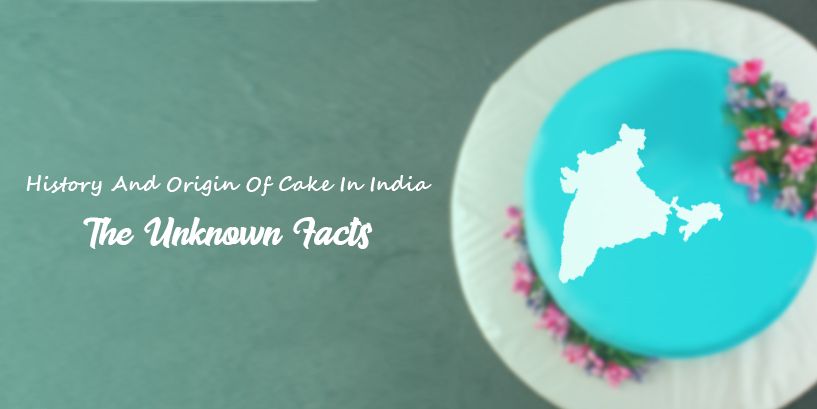Cakes are the desserts that everyone seems to love a slice of. The origin and history of cakes are as colorful and exciting as the various forms of this lovely pastry. However, the history and origin of cakes in India are still uncovered.
In India, the cake has its origin in a small town in South India. Mampally Babu of Thalassery is the first baker who established a bakery in India. The Royal Biscuit Factory was the first bakery in India. There was another bakery in Kolkata, but it catered only to the British.
The cakes and biscuits of the western world were alien to Indians. So, what led to cakes becoming a part of India’s rich culinary tradition? How did the Indians develop a taste for cake? Read on to have your questions answered.
Who baked the first cakes?
The word ‘cake’ comes from the Swedish word, ‘kaka.’ The Egyptians were the first to exhibit baking skills. The first cakes combined bread and honey. In its oldest form, cakes were bread baked in a round flat shape. The Egyptians made cakes by turning them over once during the baking process. The Greeks are famous for an early form of cheesecake. The Romans developed fruit cakes with raisins, nuts, and other foods.
Many baking enthusiasts and historians believe that the Romans added yeast as a leavening agent to cakes. Then, sometime during the 16th century, the Italians developed whipping eggs and adding them to the batter. Both of these methods produced lighter cakes. But these methods were highly time-consuming. That is when baking powder and baking soda in cakes started. So, the modern version of cake developed around the 1800s.
The most important tool for baking was the oven. Many homes did not have it even after bread became the staple food in Western countries. The rich ate the fine flour bread and cakes, and the poor ate rye and black bread. This was also because the ingredients were expensive.
How did the cake come to India?
India was a European colony for many years. Perhaps, the first cakes found their way into India, thanks to the Europeans who visited and lived in India. The Portuguese, Dutch, British and French settlers introduced baked goods in India. The Indians who traveled abroad could also have relished the baked goods from the West.
As in the West, cakes were not for the common people. We can only guess the popularity of cakes among the everyday citizens of India who worked under the British. With their tradition of high tea, the British may have given the leftovers to their servants. The cooks and other help who worked in the kitchen could have a fair idea of how cakes were baked.
Since the oven was an expensive affair, even people with the know-how to bake cakes could not afford to make them at home. The rudimentary oven of the past was a big one that was set up in the backyard. It required wood for heating. Even after industrialization, the oven was not a household commodity, especially in India.
Despite the British and other European settlers preferring to have baked delicacies, there weren’t many bakeries in India. The first bakery in India was in Kolkata, but it catered exclusively to a British clientele. Many believe that this bakery was a precursor to Nahoum’s, Kolkata’s favorite bakery.
The story of Baputti and the Christmas cake:
The story of the first cake in India originates in British India. In 1883, Mambally Bapu from Thalassery set up the Royal Biscuit Factory. Baputti, as he was fondly known, was a tea, sugar, and milk merchant. On his many travels, he perfected the art of baking cookies. He set up his bakery in Kerala.
The Royal Biscuit Factory produced 40 bread, biscuits, and buns in India’s first bakery. Soon, Baputti and his bakery grew quite famous. It was the Christmas of 1883. A British planter who had a plantation at Anjarakkandy (close to Thalassery), Murdoch Brown, went to Bapu’s bakery with a rich plum cake. He had brought the cake from England. He wanted a cake just like that, and he trusted Bapu to bake it for him. Bapu delivered and opened a new chapter in the history of cakes in India.
Bapu, who baked biscuits and bread, did not know much about cakes or the science of baking them. So, Brown demonstrated the basics of baking to Baputti. Then, he gave Baputti some ingredients that he knew were going into the cake. This included cocoa, raisins, dates, and some other dry fruits. He also suggested a brandy that Baputti could use in the cake. The Indian baker, however, had better ideas.
Little did he know that he was creating history when he used a local brew instead of the French brandy. This was made using two ingredients that the Malabar coast of India is still famous for cashew and banana. And then, for extra zing, he added the very reason the Europeans colonized India- an array of spices.
When Brown tasted the cake, he was awestruck. He immediately ordered a dozen more cakes because it was one of the best he had ever eaten. Thus, the Indian version of the plum cake was born.
Baking in India- Traditional Indian cakes:
The baking scene in India did not take off overnight. It was a gradual process. It required the typical Indian jugaad, where people explored various ways to bake without an oven. With a strict vegetarian diet that did not include eggs, many Indians were averse to the idea of cakes with eggs in them. But when has a dietary restriction stopped an Indian from relishing a delicacy.
Baking a cake was a tricky affair for Indians. The most crucial factor was the availability of ingredients. The Indian bakers faced two problems- flour and yeast. They could not get good quality flour for baking. The tropical Indian climate made baking with yeast quite tricky as well. Bakers in India quickly remedied the problem of yeast by replacing it with local brews and egg whites.
Just as the plum cake took on a new dimension in the hands of Mambally Bapu, the creative Indian folks found new ways to reinvent the humble cake. The pola of North Kerala is a testimony to rudimentary baking techniques. This cake is similar to the vanilla sponge or tea cake.
The difference- it does not use any leavening agent (yeast, baking powder, or baking soda) and is not made using an oven. It is, to date, made using a skillet or deep-bottomed pan and the stove. In earlier days, homemakers made them over the firewood stove in their kitchens.
Similarly, in Tamil Nadu, the cake was made by beating eggs, butter, and sugar using a wooden spoon or a palm. The ‘bakers’ poured it into molds and placed them on hot sand to bake it. The tins had lids with burning, live charcoal on top. This baking method was similar to the ‘dum’ method of making biryani. This method was more or less adapted all over India, and nobody knows where it originated from.
The strictly vegetarian population of India did not like to be left far behind. So what if they couldn’t use eggs? The ghee cake is quite the delicacy for looking for a quick sweet fix. The delicious aroma of ghee, the fluffy, melt-in-your-mouth texture, and the unparalleled taste make even the hard-core non-vegetarian consumer forget the absence of eggs in this cake.
Pondicherry has its slice of history- Vivikam cakes. These cakes do not use flour. Rather, they use semolina and pure ghee. As if this was not heady enough, this cake uses cashew nuts soaked in rum, candied fruits, and sometimes, citrus peels.
The East Indian Thali cake is another example of how Indians decided to do away with those ingredients that did not suit their needs. The list of ingredients includes grated coconut, semolina, egg whites, and almonds. Many cookbooks were written in the early 1900s talk about using egg whites to make the cake fluffy.
Allahabad also came up with an exciting twist to the cake. The cakes of the region included petha– candied ash-gourd. Murabba, a local version of marmalade, was used to sweeten the cakes.
Another very famous regional cake in India is the Baath cake of Goa. During the preparation of this cake, the staple ingredients of flour, milk, and butter are substituted with coconut milk, rice flour, desiccated coconut, ghee, and semolina. The batter is baked on a stovetop clay oven with hot coals placed on the lid. This was a baking method used in the 1950s in India when the availability of ovens was not as widespread.
The evolution of cakes in India:
Indian cakes are probably as varied as traditional Indian sweets. With the average Indian equating celebrations with sweets, cakes have become a staple at every celebratory occasion- birthdays, weddings, anniversaries, promotions, engagement parties, the list goes on. There is a cake for every palate- from the silky-smooth French pastries to the Indo-western mix of flavors, Indian cakes are in a league of their own.
Cakes became the preferred ‘sweet’ dish for celebration from an accompaniment for tea. However, the cakes also found a few alterations made to them, gaining popularity. First came frosting. Instead of simple vanilla cakes, a frosting made of sugar and butter became a staple for celebrations.
Again, the strict diet that many Indians followed proved a deterrent. Indians, who have always had a rather extensive repertoire of sweetmeats at their disposal, did not particularly enjoy the idea of serving cakes made with eggs or unwittingly eating them when their diet or religious beliefs did not allow it. However, this was easily remedied- the eggless varieties of cakes made their foray into the market.
With the Indian Civil Services becoming more accessible to Indians and more Indians going to England to study before India gained Independence, more Indians followed some British traditions and many Indian ones. For example, tiered wedding cakes became a part of the Great Indian Wedding.
As the years passed, cakes got an upgrade. From the tried-and-tested vanilla and chocolate sponges slathered with a generous helping of nauseously sweet buttercream, bakers diversified. More flavors became available- butterscotch, strawberry, pineapple, rainbow cakes topped the popularity charts.
Thanks to the internet, social media and enterprising culinary experts, cakes today are a far cry from the humble ones that the poders of Goa baked in the community ovens or homemakers baked in baking boxes on burning sand.
Flourless chocolate cakes for those with gluten allergies, eggless cakes, and modern French pastry are now a part of the menu of most bakeries. A look at the versatile menu at Cake Buzz should give you a fair idea of how far the Indian cake has come. We offer many flavors- mocha, butterscotch, red velvet, chocolate truffle, and fruit-based flavors like pineapple, blueberry, strawberry, to name a few.
Something from every part of the world is part of India’s obsession with cake. The jiggly-wiggly Japanese cheesecake, French chiffon cakes with mousse, American crumble cakes, Mexican tres leches cakes, Australian pavlova, and, of course, German black forest cherry cakes are part of every Indian celebration nowadays.
But in quintessential Indian style, we have found ways to include our favorite desserts into every celebration, even if we opt for cake over ghee-laden Indian sweets. If you have tried the Gulab Jamun cake, a best-seller at Cake Buzz, you will know what we mean when we say the perfect blend of Indian sweets and the cake. This cake is garnished and decorated with gulab jamun halves. The frosting for this cake has little pieces of gulab jamun that you will bite into.
And if you thought we were partial to gulab jamun, think again. The popular rasmalai also has its cake form in our Ras Malai cake. Laden with pistachios, a mix of the saffron-heavy ras and frosting, and pieces of the spongy malai, this cake is one-of-its-kind.
The Christmas cake made by Mambally Bapu set a precedent- of uniqueness. There is a cake for everyone in India. And for those who do not have a sweet tooth, there are tangy cakes like the passion fruit cake or spicy cakes that incorporate the flavors of your favorite gravy or biryani.



